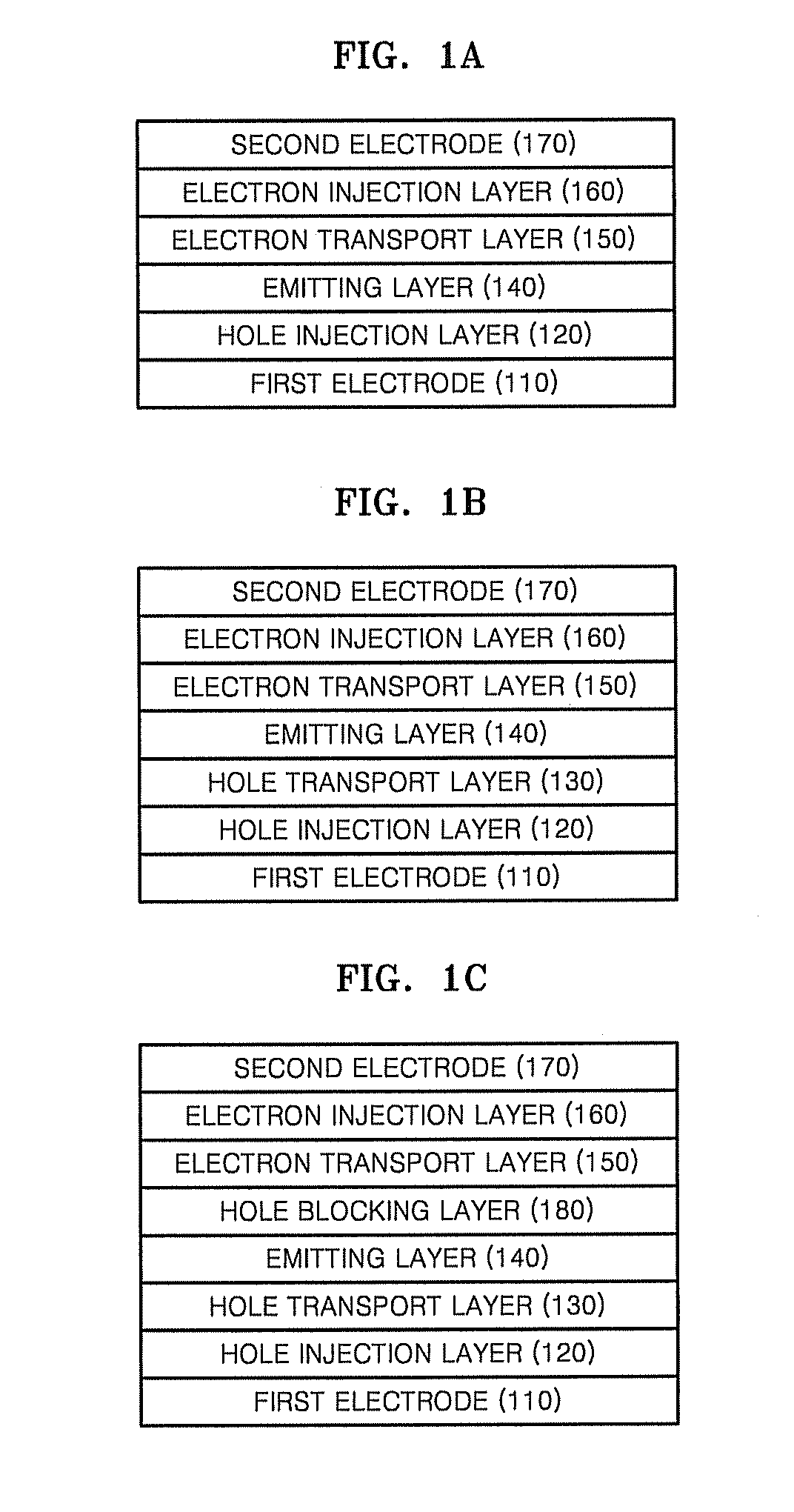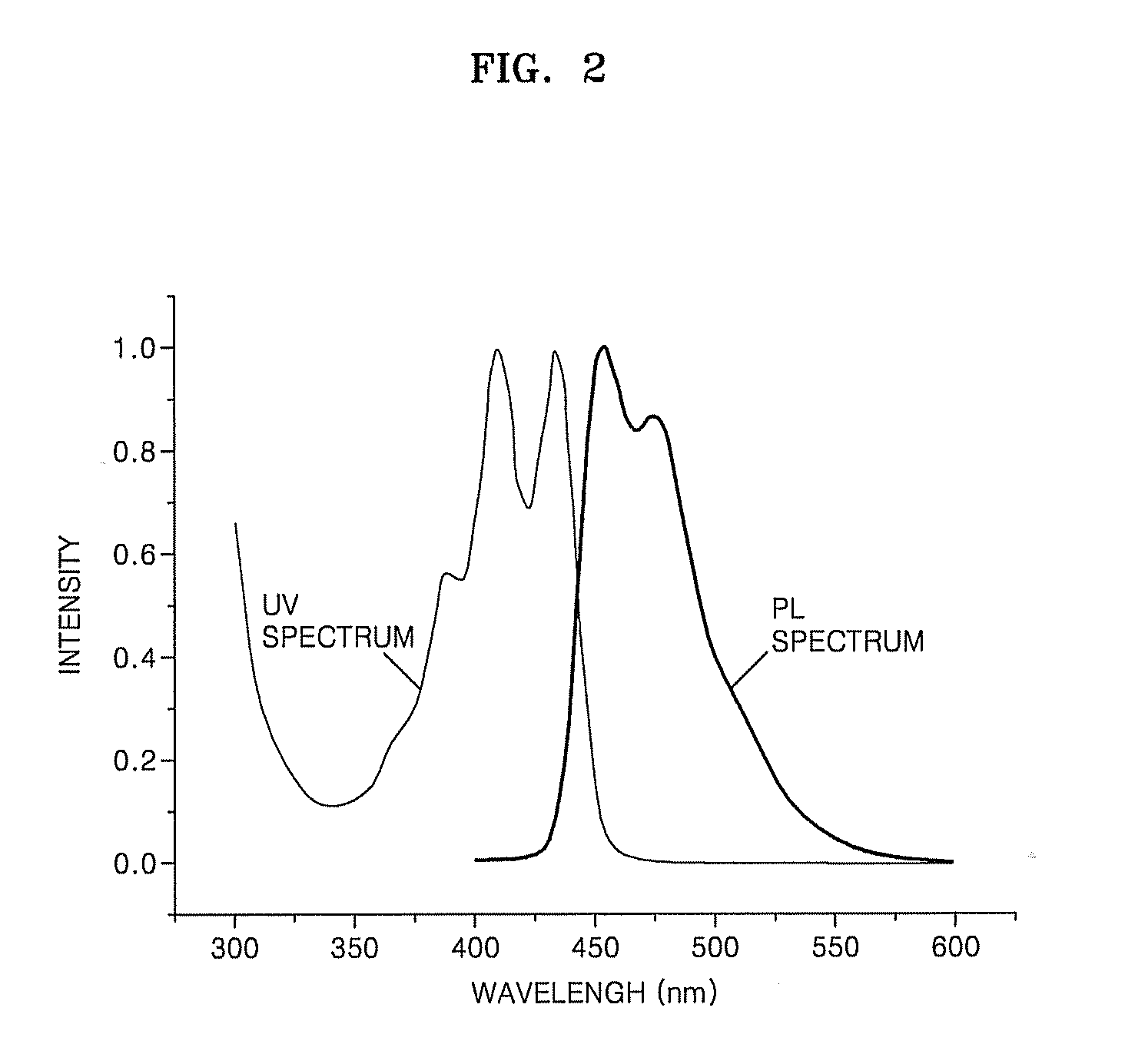Organic light-emitting compound, organic light-emitting device including the compound, and method of manufacturing the organic light-emitting device
- Summary
- Abstract
- Description
- Claims
- Application Information
AI Technical Summary
Benefits of technology
Problems solved by technology
Method used
Image
Examples
synthesis example 1
[0081]A compound 5 (corresponding to Formula 5, above) was synthesized according to Reaction Schemes 1 and 2 below.
Synthesis of Intermediate B
[0082]0.55 g (2.2 mmol) of 9-bromoanthracene was dissolved in THF (5 ml). Then, a solution of 0.6 g (2.2 mmol) of an intermediate A, 75 mg (0.06 mmol) of tetrakis triphenylphosphine palladium (Pd(PPh3)4), and 298 mg (2.2 mmol) of potassium carbonate (K2CO3) in 5 ml of toluene and 2.5 ml of water was added thereto, and the reaction mixture was refluxed for 24 hours. After the reaction was terminated, a solvent was removed by evaporation, and the residue was washed with 100 ml of ethylacetate and 100 ml of water. The organic layer was collected and dried over anhydrous magnesium sulfate. The crude product was purified by silica chromatography to give 0.20 g (yield: 27%) of an intermediate B.
Synthesis of Compound 5
[0083]1.4 g (4.2 mmol) of the intermediate B was dissolved in THF (33 ml), and phenyl magnesium bromide (PhMgBr 1.0 M, 9 ml) was added...
synthesis example 2
[0085]A compound 13 (corresponding to Formula 13, above) was synthesized according to Reaction Schemes 3 and 4 below.
Synthesis of Intermediate C
[0086]
[0087]0.73 g (2.2 mmol) of 9,10-dibromoanthracene was dissolved in THF (5 ml). Then, a solution of 0.6 g (2.2 mmol) of an intermediate A, 75 mg (0.06 mmol) of tetrakis triphenylphosphine palladium (Pd(PPh3)4), and 298 mg (2.2 mmol) of potassium carbonate (K2CO3) in 5 ml of toluene and 2.5 ml of water was added thereto, and the reaction mixture was refluxed for 24 hours. After the reaction was terminated, the solvent was removed by evaporation. The residue was washed with 100 ml of ethyl acetate and 100 ml of water, and the organic layer was collected and dried over anhydrous magnesium sulfate. The crude product was purified by silica chromatography to give 0.45 g (yield: 43%) of an intermediate C.
Synthesis of Compound 13
[0088]1.0 g (2.1 mmol) of the intermediate C was dissolved in THF (15 ml), and phenyl magnesium bromide (PhMgBr 1.0 M...
synthesis example 3
[0090]A compound 28 (corresponding to Formula 28 above) was synthesized according to Reaction Schemes 5 and 6 below.
Synthesis of Intermediate D
[0091]1.5 g (4.4 mmol) of 9-bromo-10-phenyl anthracene was dissolved in THF (10 ml). Then, a solution of 1.2 g (4.4 mmol) of an intermediate A, 150 mg (0.12 mmol) of tetrakis triphenylphosphine palladium (Pd(PPh3)4), and 600 mg (4.4 mmol) of potassium carbonate (K2CO3) in 10 ml of toluene and 5 ml of water was added thereto and the reaction mixture was refluxed for 24 hours. After the reaction was terminated, solvent was removed by evaporation. The residue was washed with 200 ml of ethylacetate and 200 ml of water, and the organic layer was collected and dried over anhydrous magnesium sulfate. The crude product was purified by silica chromatography to give 0.85 g (yield: 39%) of an intermediate D.
Synthesis of Compound 28
[0092]1.1 g (2.9 mmol) of the intermediate D was dissolved in THF (18 ml), and phenyl magnesium bromide (PhMgBr 1.0 M, 6 ml)...
PUM
| Property | Measurement | Unit |
|---|---|---|
| Electric potential / voltage | aaaaa | aaaaa |
| Wavelength | aaaaa | aaaaa |
| Wavelength | aaaaa | aaaaa |
Abstract
Description
Claims
Application Information
 Login to View More
Login to View More - R&D
- Intellectual Property
- Life Sciences
- Materials
- Tech Scout
- Unparalleled Data Quality
- Higher Quality Content
- 60% Fewer Hallucinations
Browse by: Latest US Patents, China's latest patents, Technical Efficacy Thesaurus, Application Domain, Technology Topic, Popular Technical Reports.
© 2025 PatSnap. All rights reserved.Legal|Privacy policy|Modern Slavery Act Transparency Statement|Sitemap|About US| Contact US: help@patsnap.com



